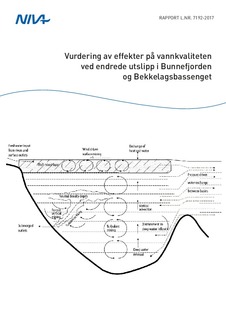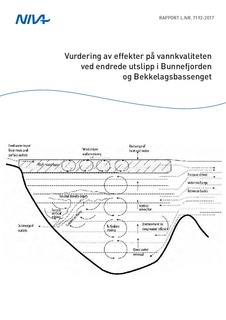| dc.contributor.author | Staalstrøm, Andre | |
| dc.contributor.other | Staalstrøm, André - Project manager | |
| dc.date.accessioned | 2018-01-29T09:35:49Z | |
| dc.date.available | 2018-01-29T09:35:49Z | |
| dc.date.created | 2018-01-24T16:14:30Z | |
| dc.date.issued | 2017 | |
| dc.identifier | 7192 | |
| dc.identifier.isbn | 978-82-577-6927-7 | |
| dc.identifier.issn | 1894-7948 | |
| dc.identifier.uri | http://hdl.handle.net/11250/2480178 | |
| dc.description.abstract | På grunn av liten vertikal blanding i Bunnefjorden oppstår det i dag anoksiske forhold, som kan vare i flere år. Modellsimuleringen med NIVA Fjordmodell (NFM) gjenskaper tilsvarende forhold. Ved å føre en vannmengde på 500-1000 L/s til 100 m dyp i Bunnefjorden, viser modellsimuleringene at dette vil føre til en dramatisk forbedring av forholdene her. Ved å overføre 500 L/s, fra BRA og 148 L/s fra Nordre Follo renseanlegg (NFR) til 100 m dyp i Bunnefjorden, vil dette føre til at de anoksiske forholdene får en mye kortere varighet. I stedet for å ha anoksiske forhold som varer i flere år, så får man en varighet på mindre enn ett år. Ved å samlet overføre 1000 L/s kan effekten bli at man stort sett unngår anoksiske forhold bortsett fra i kortere perioder i enkelte år. Ved en reduksjon av vannmengden til 1000 eller 500 L/s økes risikoen betydelig for at anoksiske forhold oppstår i bunnvannet i Bekkelagsbassenget. Denne økte risikoen ser ut til å kunne elimineres om utslippsrøret senkes fra 50 m til 65 m dyp. Utslippsdypet i Bunnefjorden bør minst være 100 m. En overføring av vann fra 50 m i Bekkelagsbassenget til 60 m i Bunnefjorden har en negativ effekt på vannkvaliteten i begge bassengene. | nb_NO |
| dc.description.abstract | Before the year 2000, the basin Bekkelagsbassenget had episodes of anoxic water all the way up to the sill depth between Bekkelagsbassenget and Bunnefjorden at approx. 43 m. This improved dramatically when the discharge from the Bekkelaget purification plant (BRA) were lowered to 50 m
depth in the Bekkelagsbassenget around the year 2000. By reducing the amount of water released at the depth of 50 m in Bekkelagsbassenget, the water quality could again be worsened. In today's situation, where an annual average amount of about 1500 L/s is released at 50 m depth,
there are regular hypoxic conditions (oxygen concentrations below 1 ml O2/L) for periods of a few months, virtually every year in the deeper parts of the water mass in Bekkelagsbassenget, deeper than about 55 meters. On the other hand, anoxic water is avoided, but the conditions are on the verge of anoxic conditions. With a reduction of the water flow in the discharge to 1000 or 500 L/s, the risk is significantly increased for anoxic conditions in the bottom water of Bekkelagsbassenget. This increased risk seems to be eliminated if the discharge pipe is lowered from 50 m to 65 m depth. Due to the small vertical mixture in the basin Bunnefjorden, there are today anoxic conditions that can last for several years. Model simulation with NIVA Fjord model (NFM) recreates corresponding conditions. By discharging a water flow of 500-1000 L/s to 100 m depth in Bunnefjorden, model simulations show that this will dramatically improve the conditions here. By transferring 500 L/s, from BRA and 148 L/s from Nordre Follo purification plant (NFR) to 100 m depth in Bunnefjorden, this will cause the periods with anoxic conditions to be much shorter. Instead of having anoxic conditions lasting for several years, you get a duration of less than a year. By transferring 1000 L/s from BRA, the effect may be to avoid anoxic conditions, except for shorter periods in a few years.
There are uncertainties related to the modeling, for instance the amount of organic matter, sulfide and phosphate available in the sediments. The model series describes situations on the fluctuating between anoxic and hypoxic conditions, and processes in the sediments, can be decisive. Considering the uncertainties in the model and the high risk of reducing the water quality in Bekkelagsbassenget, there should not be a permanent reduction in the amount of water in the discharge to 50 m depth in Bekkelagsbassenget, unless the discharge pipe is lowered at the same time. The discharge depth in Bunnefjorden should be at least 100 m. A transfer of water from 50 m in Bekkelagsbassenget to 60 m in Bunnefjorden has a negative effect on the water quality in both basins. | nb_NO |
| dc.description.sponsorship | Fagrådet for vann- og avløpsteknisk samarbeid i indre Oslofjord | nb_NO |
| dc.language.iso | nob | nb_NO |
| dc.publisher | Norsk institutt for vannforskning | nb_NO |
| dc.relation.ispartof | NIVA-rapport | |
| dc.relation.ispartofseries | NIVA-rapport;7192 | |
| dc.rights | Navngivelse-Ikkekommersiell-DelPåSammeVilkår 4.0 Internasjonal | * |
| dc.rights.uri | http://creativecommons.org/licenses/by-nc-sa/4.0/deed.no | * |
| dc.subject | Oksygenforhold | nb_NO |
| dc.subject | Oxygen conditions | nb_NO |
| dc.subject | Fjorddynamikk | nb_NO |
| dc.subject | Fjord dynamics | nb_NO |
| dc.subject | Oslofjorden | nb_NO |
| dc.subject | Oslo fjord | nb_NO |
| dc.subject | NIVA Fjordmodell | nb_NO |
| dc.subject | NIVA Fjord model | nb_NO |
| dc.title | Vurdering av effekter på vannkvaliteten ved endrede utslipp i Bunnefjorden og Bekkelagsbassenget | nb_NO |
| dc.title.alternative | Assessment of the effects on the water quality of changed discharges in Bunnefjorden and Bekkelagsbassenget | nb_NO |
| dc.type | Research report | nb_NO |
| dc.description.version | publishedVersion | nb_NO |
| dc.rights.holder | Norsk institutt for vannforskning / Norwegian Institute for Water Research | nb_NO |
| dc.subject.nsi | VDP::Matematikk og naturvitenskap: 400 | nb_NO |
| dc.subject.nsi | VDP::Mathematics and natural scienses: 400 | nb_NO |
| dc.source.pagenumber | 36 | nb_NO |
| dc.source.issue | 7192 | nb_NO |
| dc.identifier.cristin | 1551244 | |
| dc.relation.project | 17256 | nb_NO |
| cristin.unitcode | 7464,20,14,0 | |
| cristin.unitname | Marin biogeokjemi og oseanografi | |
| cristin.ispublished | true | |
| cristin.fulltext | original | |


